从《钱江涌潮》英译文谈旅游英语翻译技法
试论旅游宣传广告的翻译艺术——从“桂林山水甲天下”的英译谈起及试谈教学中成语积累与应用的尝试
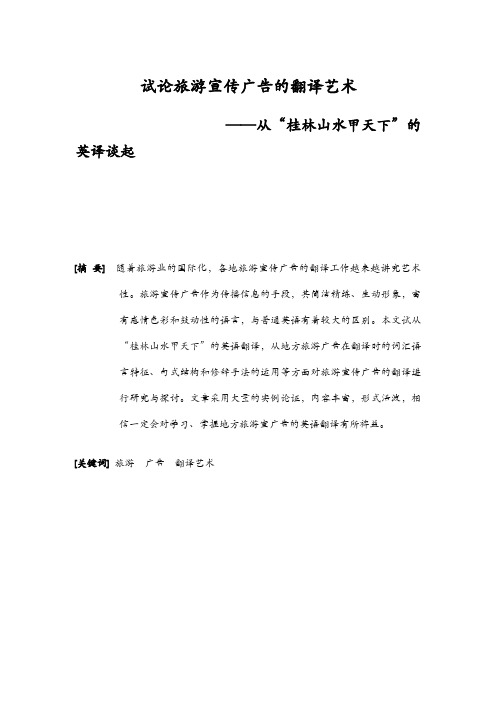
试论旅游宣传广告的翻译艺术——从“桂林山水甲天下”的英译谈起[摘要] 随着旅游业的国际化,各地旅游宣传广告的翻译工作越来越讲究艺术性。
旅游宣传广告作为传播信息的手段,其简洁精练、生动形象,富有感情色彩和鼓动性的语言,与普通英语有着较大的区别。
本文试从“桂林山水甲天下”的英语翻译,从地方旅游广告在翻译时的词汇语言特征、句式结构和修辞手法的运用等方面对旅游宣传广告的翻译进行研究与探讨。
文章采用大量的实例论证,内容丰富,形式活泼,相信一定会对学习、掌握地方旅游宣广告的英语翻译有所裨益。
[关键词] 旅游广告翻译艺术前言桂林不仅是世界著名的风景旅游城市,而且还是中国历史文化名城。
多年以来,桂林市在旅游资源开发中,注意挖掘2100多年来的历史文化旅游资源,整合现有的文化旅游景点,形成了一系列的旅游文化产品,使之成为有吸引力的桂林旅游文化品牌。
传播八百多年的“桂林山水甲天下”这一名句,是桂林旅游文化内涵的精髓所在,从南宋以来就广泛流传于世并深入人心。
为了不断创新桂林旅游理念,打造桂林旅游新品牌,建设桂林旅游精品,规范“桂林山水甲天下”的外文译法,桂林市委、市政府和中国翻译工作者协会曾在2005年和2006年两次共同召开新闻发布会,面向全世界征集“桂林山水甲天下”的最佳译文,目的是通过用不同国家语言对“桂林山水甲天下”的表述,进一步弘扬桂林山水文化的精髓,让桂林更快地走向世界[1]。
专家、学者通过对来自世界各地征集的译文进行严格评审、翻译,保证了译文的质量。
桂林市委、市政府把40多个国家用本国文字对“桂林山水甲天下”的译文,以碑文的形式摹刻在桂林南溪山公园的“桂林山水甲天下艺术园”内,进行永久展示,延伸了“桂林山水甲天下”名句的文化内涵,达到了“同句异字,各显风采”、“同句异音,尽得名声”的境界和意境。
根据美国广告大师E S 鲁易斯(E S Lewis) 的AIDA原则,一个成功的广告应当具备以下四点:Attention(引人注意)、Interest(使人感兴趣)、Desire(引发欲望)、Action(促进行动)。
旅游外宣文本的汉英翻译探析_以泉州地区旅游景点英译文本为例_王才英
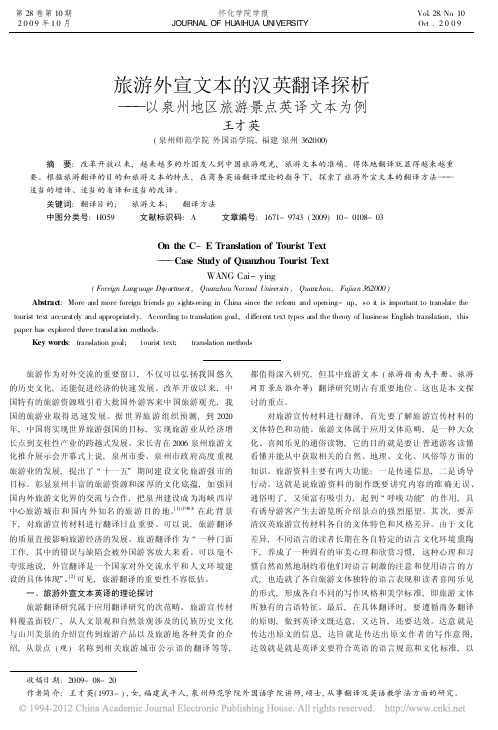
旅游外宣文本的汉英翻译探析)))以泉州地区旅游景点英译文本为例王才英(泉州师范学院外国语学院,福建泉州362000)摘 要:改革开放以来,越来越多的外国友人到中国旅游观光,旅游文本的准确、得体地翻译就显得越来越重要。
根据旅游翻译的目的和旅游文本的特点,在商务英语翻译理论的指导下,探索了旅游外宣文本的翻译方法)))适当的增译、适当的省译和适当的改译。
关键词:翻译目的; 旅游文本; 翻译方法中图分类号:H059 文献标识码:A 文章编号:1671-9743(2009)10-0108-03On the C -E Translation of Tourist Text )))Case Study of Quanzhou Tourist TextWANG Cai-ying(Foreign Lan guage De p a rtmen t ,Quanzhou Normal University ,Quan z hou,Fujian 362000)Abstract :More and more foreign friends go si ghtseeing in China since the reform and opening-up,so it is i mportant to translate the tourist text accurately and appropriately.According to translation goal,different text types and the theory of business English translation,this paper has explored three translation methods.Key words :translation goal; touris t text; translation methods收稿日期:2009-08-20作者简介:王才英(1973-),女,福建武平人,泉州师范学院外国语学院讲师,硕士,从事翻译及英语教学法方面的研究。
从《钱江涌潮》英译文谈旅游英语翻译技法

从《钱江涌潮》英译文谈旅游英语翻译技法《钱江涌潮》The Tidal Bore of the Qiantang River八月十八潮,On the eighteenth of the eighth lunar month,壮观天下无The tidal bore of the Qiantang River, Is a grand view second to none on earth.浙江钱塘江河口的涌潮,自古蔚为天下奇观。
它是大自然赋予的神奇景象。
由于天体引力和地球离心作用,每逢农历初一至初五,十五至三十,天体引潮力特别强,易形成大潮;农历八月十八日的大潮尤为壮观。
而杭州湾喇叭口的地形特殊,海湾水域广阔,但河口狭窄,加之河床泥沙阻挡,易使潮流能量集中,江潮迅速猛涨,流速加快,涌潮现象频频发生。
钱江涌潮,一年四季,周而复始。
全年共有120天的“观潮日”。
The tidal bore located at the mouth of the Qiantang River in Zhejiang affords a magnificent view and constitutes a remarkable natural phenomenon. The bore is at its highest from the first day to the fifth, and from the fifth day to the twentieth every month according to the lunar calendar. At this time, the moon and the sun exert the greatest pull on the ocean at the mouth of the Qiantang River. The bore is at its most spectacular every September on the eighteenth day of the lunar calendar’s eighth month. The river’s special physical features account for this remarkable natural phenomenon. Its outlet to the ocean, Hangzhou Bay, is extremely wide, shaped like a large trumpet. When the sea tide rises, it brings with it a huge amount of water, pushing inland at a great speed. However, the river narrows abruptly at this point. This, together with the river’s sandy bed, prevents the water’s smooth progress. As waves follow one after the other, the tide surges and creates a gigantic wall of tidal water, the so-called “tidal bore”. The tidal bore operates in a cycle; there are only 120 days on which it is good to watch the bore. Moreover, there are two tides per day, the day tide and the night tide.每天有日、夜两潮,尤以秋潮为最佳。
从翻译功能学视角分析大雁塔景点牌示英译

38海外文摘0 引言中国是一个历史悠久的文明古国,随着中国对外开放的程度加深,越来越多的外国游客希望借助游历中国名山大川、名胜古迹以了解中国的历史文化。
旅游翻译作为一门专业翻译为推广中国历史文化起到了举足轻重的作用。
旅游翻译种类繁多,本文以大雁塔景点双语牌示作为一个案例,套用德国功能翻译理论,分析景点牌示的汉英翻译策略。
1 文本类型分析翻译是一种交际行为,行为主体是人,行为载体是语言。
本案例中景点牌示汉英翻译的本质是一种跨文化的交际行为(汉英两种语言文化)和文本处理行为(套用弗米尔的话,翻译是在目标语文化中重现源语语言文化所提供的某些信息)。
下面,笔者通过分析本案例中大雁塔景点牌示的文本类型来阐述景点牌示汉英翻译的过程是如何完成。
首先,什么是景点牌示?“景点牌示属于旅游翻译里景点解说翻译中最主要的、使用频率最高的自导式解说系统的表达方式。
自导式解说是由书面材料、标准公共信息图形符号、语音等无生命设施或设备向游客提供静态的、被动的信息服务。
景点牌示,在内容上,要向普通游客提供相关的自然、地理、文化、风俗等方面的知识;在语言表达上,要力求准确、通俗、明了、富有吸引力,便于不同层面读者的理解和接受”。
[1]那么,景点牌示属于什么类型的文本。
在笔者回答这个问题前,先来看看文本类型的理论基础。
文本类型理论的代表人物是凯瑟琳娜·赖斯(KatharinaReiss),她借用了德国心理学家、功能语言学家卡尔·布勒(K.B ühler)的语言功能三分法,将布勒确认的语言三种功能——信息功能、表情功能和感染功能与其对应的语言维度、文本类型和各自使用的交际环境联系起来。
赖斯把文本类型分为:信息型文本、表情型文本和操作型文本。
[2]德国功能派另一名代表人物克里斯蒂安·诺德(Christiane Nord)在布勒的语言功能工具模式和赖斯的文本类型模式的基础上,结合雅各布逊(R .Jacobson)的语言功能模式(1959;1960)和纽马克(P. Newmark)的语言功能与文本类型(1988),把翻译文本功能分为:指称功能、表情功能、感染功能和寒暄功能。
Lecture 14 Tourism Style Translation (2)
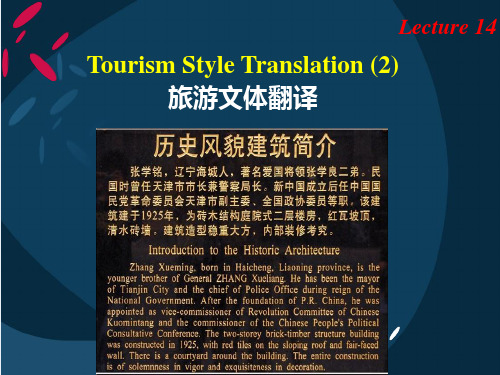
• 原文:满树金花、芳香四溢的金桂;花白如雪、 香气扑鼻的银桂;红里透黄、花朵味浓的紫砂桂; 花色似银、季季有花的四季桂;竞相开放、争艳 媲美。进入桂林公园,阵阵桂香扑鼻。
• 译文:The park of Sweet Osmanthus is noted for its profusion of osmanthus trees. Flowers from these trees in different colors are in full bloom which pervade the whole garden with the fragrance of their blossoms. • 译文打破原文的句子排列,改写原文华丽词藻 和细节描写,整体概括,简洁明白。
’
• •
楹联翻译是旅游翻译的一大难题
在翻译实践中,可采用不同的方法来翻译不同 的楹联俳语,如词汇的对应,句子结构的对应, 必要时可改写句子结构等。
• 山海关有一副楹联为: 海水朝朝朝朝朝朝朝落 浮云长长长长长长长消
‘
• 采用字面对应(literal translation)可译为: • Sea waters tide, day to day tide, every day tide and every day ebb, • Floating clouds appear, often appear, often appear and often go.
,
• 5、保持语用层对应 子孙贤族将大 兄弟睦家之肥 • 英译1: • Virtuous, offspring will make the clan flourish; • Harmonious, brothers will make the family prosper. • (译文暗含原文结构)
等值视角下的旅游景点资料翻译
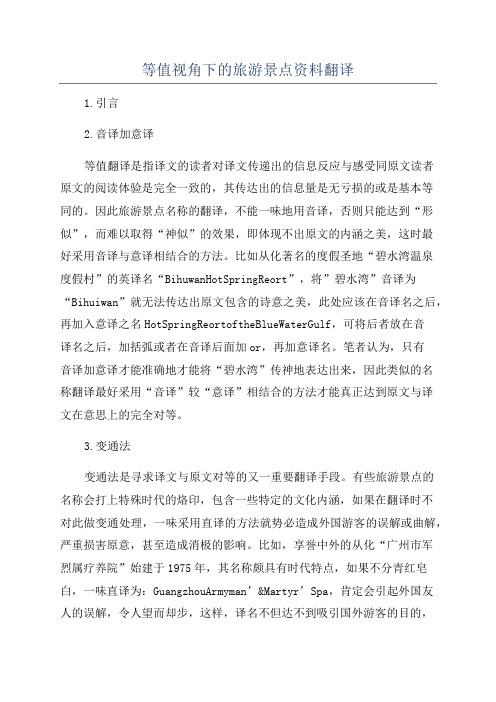
等值视角下的旅游景点资料翻译1.引言2.音译加意译等值翻译是指译文的读者对译文传递出的信息反应与感受同原文读者原文的阅读体验是完全一致的,其传达出的信息量是无亏损的或是基本等同的。
因此旅游景点名称的翻译,不能一味地用音译,否则只能达到“形似”,而难以取得“神似”的效果,即体现不出原文的内涵之美,这时最好采用音译与意译相结合的方法。
比如从化著名的度假圣地“碧水湾温泉度假村”的英译名“BihuwanHotSpringReort”,将”碧水湾”音译为“Bihuiwan”就无法传达出原文包含的诗意之美,此处应该在音译名之后,再加入意译之名HotSpringReortoftheBlueWaterGulf,可将后者放在音译名之后,加括弧或者在音译后面加or,再加意译名。
笔者认为,只有音译加意译才能准确地才能将“碧水湾”传神地表达出来,因此类似的名称翻译最好采用“音译”较“意译”相结合的方法才能真正达到原文与译文在意思上的完全对等。
3.变通法变通法是寻求译文与原文对等的又一重要翻译手段。
有些旅游景点的名称会打上特殊时代的烙印,包含一些特定的文化内涵,如果在翻译时不对此做变通处理,一味采用直译的方法就势必造成外国游客的误解或曲解,严重损害原意,甚至造成消极的影响。
比如,享誉中外的从化“广州市军烈属疗养院”始建于1975年,其名称颇具有时代特点,如果不分青红皂白,一味直译为:GuangzhouArmyman’&Martyr’Spa,肯定会引起外国友人的误解,令人望而却步,这样,译名不但达不到吸引国外游客的目的,可能会适得其反,吓走国外游人,造成不好懂得影响。
那么在翻译该名称时,就应该采用变通的方法,将其译为:GuangzhouHotSpringReort,这样既准确地表达了其含义,也能取到良好的宣传的效果,也达到了意思上更深层次的对等。
4.译文风格一致法翻译的过程还要考虑译文的前后一致性,比如,景点名称翻译倘若名采意译的手法,那么最好前后风格一致,否则会破坏译文的统一性,失去表达上的和谐之美。
论旅游翻译中文化差异的处理_1

论旅游翻译中文化差异的处理导读:本文论旅游翻译中文化差异的处理,仅供参考,如果觉得很不错,欢迎点评和分享。
the Chinese history who unified China in theyear B.C. 221”,就更容易被外国游客所理解。
因此,许多专家主张以音译加注的方式来保留这类词汇的特殊文化联想意义。
译者在翻译时要克服的不仅有语言障碍,而且有文化障碍,正如王佐良(1989)先生所说的“译者处理的是两种文字,面对的却是两大片文化”。
(二)译者对旅游文本中的背景知识理解欠缺造成的误解例如,杭州的导游翻译在向国外游客介绍风景名胜时,首先遇到的是如何翻译风景地名的问题。
杭州有名的风景都有其历史渊源和文化背景,翻译时稍一不慎,便会产生错误。
如人们往往将虎跑泉的“跑”字念成“pao”,结果虎跑泉的英译成了“Tiger Running Spring”。
其实,“跑”是多音字:一个念pao(即跑步的“跑”),另一个念pao(意为兽用爪扒土)。
虎跑泉的“跑”应念作“paO”。
相传唐代元和十四年(公元819年),有位法名性空的高僧云游至今日的虎跑寺,想栖禅于此,但一直苦于无水,准备迁走。
夜里忽然梦见神仙相告:“南岳有童子泉,当遣二虎移来。
”次日清晨,性空果见有二虎“跑地作泉”,泉水涌出。
于是,他就建寺居住,并把此泉起名为“虎跑泉”。
因此,虎跑泉可直译为“Tiger-clawed Spring”。
外国游客在中国除了游览和娱乐之外,还少不了吃。
中华民族的“食文化”博大精深,仅就菜式的取名而言就颇为多姿多彩。
例如,有一道菜式叫“金华玉树鸡”。
古语“华”和“花”相通,如果照字面翻译,那便是“Chicken cooked with golden flower and jade tree”。
可是,菜中既无花,更无树,这样的翻译肯定会令人听后摸不着头脑。
原来,浙江金华以产火腿而著名。
青菜形似玉树,这道典型的菜肴不过是“火腿青菜鸡”罢了,向外宾介绍,可译为“Sliced chicken and ham with greens”。
古诗中地名英译的方法分析——以许渊冲先生的译本为例
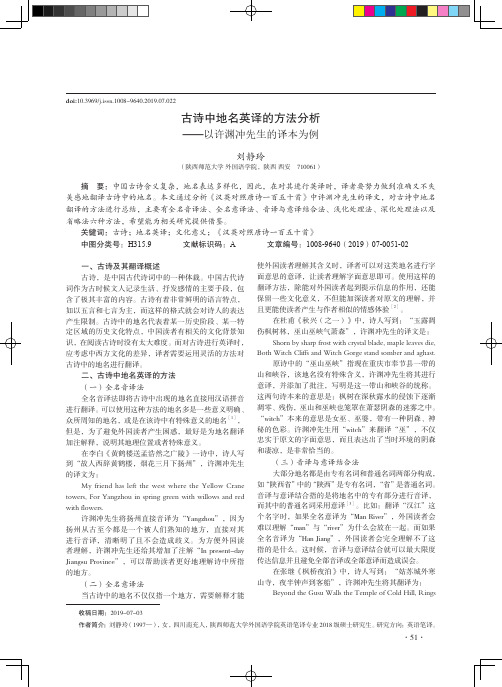
刘静玲
(陕西师范大学 外国语学院,陕西 西安 710061)
摘 要:中国古诗含义复杂,地名表达多样化,因此,在对其进行英译时,译者要努力做到准确又不失
美感地翻译古诗中的地名。本文通过分析《汉英对照唐诗一百五十首》中许渊冲先生的译文,对古诗中地名
翻译的方法进行总结,主要有全名音译法、全名意译法、音译与意译结合法、浅化处理法、深化处理法以及
收稿日期:2019-07-03 作者简介:刘静玲(1997—),女,四川南充人,陕西师范大学外国语学院英语笔译专业 2018 级硕士研究生。研究方向:英语笔译。
·51·
bells which reach my boat, breaking the midnight still候,已经提到这个句子。其
使外国读者理解其含义时,译者可以对这类地名进行字 面意思的意译,让读者理解字面意思即可。使用这样的 翻译方法,除能对外国读者起到提示信息的作用,还能 保留一些文化意义,不但能加深读者对原文的理解,并 且更能使读者产生与作者相似的情感体验[2]。
在杜甫《秋兴(之一)》中,诗人写到:“玉露凋 伤枫树林,巫山巫峡气萧森”,许渊冲先生的译文是:
(三)音译与意译结合法 大部分地名都是由专有名词和普通名词两部分构成, 如“陕西省”中的“陕西”是专有名词,“省”是普通名词。 音译与意译结合指的是将地名中的专有部分进行音译, 而其中的普通名词采用意译[3]。比如:翻译“汉江”这 个名字时,如果全名意译为“Man River”,外国读者会 难以理解“man”与“river”为什么会放在一起。而如果 全名音译为“Han Jiang”,外国读者会完全理解不了这 指的是什么。这时候,音译与意译结合就可以最大限度 传达信息并且避免全部音译或全部意译而造成误会。 在张继《枫桥夜泊》中,诗人写到:“姑苏城外寒 山寺,夜半钟声到客船”,许渊冲先生将其翻译为: Beyond the Gusu Walls the Temple of Cold Hill, Rings
钱塘江观潮英语作文

The Spectacle of the Qiantang River TidalBoreNestled within the eastern coast of China, the Qiantang River stands as a natural wonder, renowned for its powerful and majestic tidal bore. Each year, the river attracts thousands of visitors from around the globe, who come to witness the remarkable phenomenon of the tidal bore. The experience is not just a sight to behold, but a thrilling and awe-inspiring encounter with nature's raw power.The Qiantang River, known for its unique geographical characteristics, is situated where the river's narrowest point meets the East China Sea. This particular configuration, combined with the lunar and solar tidal forces, creates the perfect conditions for the formation of the tidal bore. As the tide surges in from the sea, it collides with the river's narrowing banks, causing a rapid rise in water level and a powerful surge of water that rushes upstream.The sight of the tidal bore is truly breathtaking. As the wave approaches, it appears as a wall of water, advancing rapidly towards the onlookers. The roar of thewater can be heard from miles away, a deafening sound that adds to the drama of the moment. As the wave hits the riverbanks, it rises up in a towering column of water, spraying mist and droplets into the air. The force of the impact is so strong that it can be felt even from a safe distance.Watching the tidal bore is not just about seeing the wave itself. It's about experiencing the energy and the power of nature. It's about feeling the vibration of the earth as the wave crashes against the shore and about smelling the fresh, sea-tinged air. It's about sharing this incredible moment with fellow observers, each of them overcome with a sense of awe and wonder.The Qiantang River tidal bore is not just a natural phenomenon; it's a cultural experience. For generations, the Chinese people have come to the river to witness this amazing sight and to celebrate it with festivals and traditions. The tidal bore has become a symbol of the region, representing its unique natural beauty and the resilience of its people.In conclusion, the Qiantang River tidal bore is a must-see natural wonder. It is a testament to the awesome power of nature and a reminder of our small place in the grand scheme of the universe. Witnessing the tidal bore is an experience that will stay with you forever, leaving you with a profound respect for the forces of nature and a renewed sense of wonder and amazement.**钱塘江观潮**位于中国东部的钱塘江,因其壮观的涌潮而闻名于世。
钱塘江大潮观后感英语

钱塘江大潮观后感**Reflections on the Spectacular Qiantang River Tide** The Qiantang River Tide, a natural wonder renowned throughout the world, left me deeply impressed and awestruck. Witnessing this phenomenon was a truly unforgettable experience, one that filled me with a sense of both wonder and humility.The day began with a sense of anticipation and excitement. As we approached the riverbank, theanticipation grew, and I could feel the energy in the air. The sky was a clear blue, and the sun cast its warm light across the river, setting the stage for the impending spectacle.As the predicted time for the tide's arrival drew nearer, the crowd grew increasingly excited. Suddenly, a roar could be heard in the distance, like the rumble of distant thunder. It grew louder and louder, until it filled the air, shaking the ground beneath our feet. Then, the moment arrived.The incoming tide was a sight to behold. It surged forward with an unstoppable force, a wall of water that seemed to stretch as far as the eye could see. The waterwas a deep, inky blue, and it moved with a power and precision that was both beautiful and terrifying. The roarof the water grew louder as it approached, and the air seemed to vibrate with its power.As the tide reached its peak, it seemed to tower over us, a massive wave that threatened to engulf everything in its path. Yet, as quickly as it had come, the tide began to withdraw, leaving the riverbank bathed in a sheen of dampness and the air filled with the salty scent of the sea. The entire experience was both thrilling and humbling.It was thrilling to witness the raw power of nature, to see how something so vast and uncontrollable could move with such precision and force. And it was humbling to realizehow small and insignificant we are in the grand scheme ofthe universe, how easily nature can overwhelm our existence. Watching the Qiantang River Tide was not just a visual experience; it was a profound reminder of the power and beauty of nature. It was a reminder that, while we maystrive to control and understand our world, there areforces that are beyond our comprehension and control.In conclusion, the Qiantang River Tide was a truly awe-inspiring experience. It left me with a renewed sense of respect and admiration for the natural world, and a deeper understanding of my place within it. I am grateful for the opportunity to have witnessed such a remarkable phenomenon, and I will carry the memory of that day with me always.**钱塘江大潮观后感**钱塘江大潮,这一世界闻名的自然奇观,给我留下了极为深刻的印象,令人叹为观止。
Translation of the Names of Scenic Spots

4、语用不得当
小心碰头 Take care of your head 本来愿意是善意提醒游客不要碰头,而take care of 是“照 顾” “爱护” 处理的意思,根本没有表示出原公示语中提示和 警示的功能。
Introduction
1、Tourism is considered to be one of the three sunrise industries in the 21st century.
Examples
Pentagon 五角大楼:渲染解释
the Statue of Liberty 自由女神像 Arch of Triumph 凯旋门:属性特色词前调(直译)
Chinese to English
御花园
布达拉宫
鼓浪屿 岳阳楼 人民大会堂
the Gate of Devine Might; the Imperial Garden Potala Palace Gulangyu Islet Yueyang Tower Great Hall of People
黄鹤楼 Yellow Crane Tower
雨花台 Rain of Flowers Terrace
包公祠 lord Bao Memorial Temple
音译 + 直译(transliteration + Literal Translation)
1、前面含表示特定人名或地名的专有名称,又包含固定的表示景点名称的通名。
杜甫草堂 Dufu Cottage
少林寺
都江堰
Shaolin Temple
Dujiang Dam
2、如果含表示专有名称是单个字,翻译时把其后的通用名称也音译出来,后面再加上这 个通名的英译。 嵩山 Songshan Mountain 梅岭 Meiling Mountain 漓江 Lijiang River
第二章 常用旅游文本翻译技巧3

Case Study
白帝城是一座颇享声誉的“诗城”。我国历代许多著 名的诗人都曾来此观景咏诗。“诗仙”李白的《早发 白帝城》,已成为不朽的佳作。……“诗圣”杜甫在 此两年,写下了437首诗,占现存杜诗的三分之 一。……刘禹锡在夔州民歌的基础上,首创了充满生 活气息和三峡特色的《竹诗词》。1963年春天,毛泽 东乘“江峡”轮视察长江三峡时,船航行至白帝城下, 触景生情,兴致勃勃地咏诵: “朝辞白帝彩云间, 千里江陵一日还。 两岸猿声啼不住, 轻舟已过万重山 ”
Qingdao is a beautiful coastal city. It is cool in summer and warm in winter. The 40-km-long scenic line begins from Tuandao Island at the west end to Xiaqinggong of Mount Lao at the east end.
2005年,冰川快车迎来了自己75周年生日的庆典。 一切都始于20世纪20年代的黄金时代。当时,对 阿尔卑斯登山爱好者冒险行为的报道吸引了世界 各地的上流社会成员前来探索瑞士阿尔卑斯山的 荒凉之美,于是采尔马特和圣莫里茨等以前偏僻 的山村变成了著名的旅游胜地。政府发现了火车 探险旅游的潜力,最终,冰川快车于1930年6月 25日首次从圣莫里茨开往采尔马特。当时,整个 旅程耗时11小时,旅客乘坐的是优雅的特等客车 和经特别改装的客车。
Practice
秦始皇统一六国后,一方面拆毁诸国间的长城,另一 方面为防御北边匈奴,又再修筑了横亘万余里的长城, 成为我国最早的万里长城。此后的各朝各代都对长城 进行了修复和加固。 After unifying all other six states, Emperor Qinshihuang, the first emporer of the Qin Dynasty, while pulling down the walls between the former states, had new walls built in the north to defend the Hun. The walls stretched more than five thousand kilometres, forming the oldest Great Wall. From then on, it was restored and reinforced by successive dynasties.
钱歌川-翻译的技巧
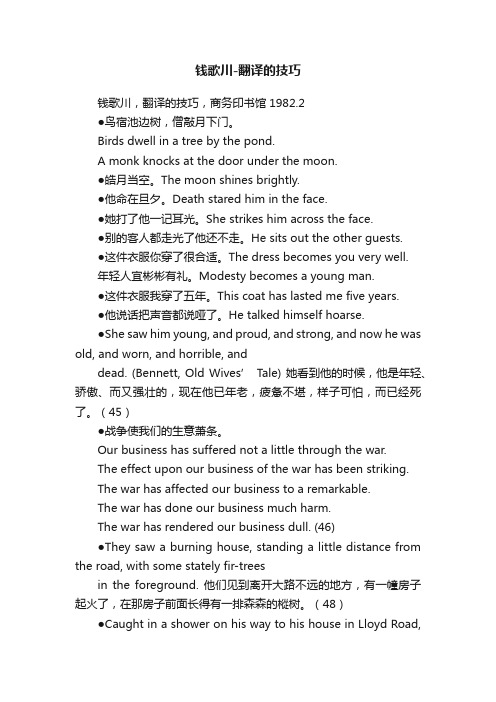
钱歌川-翻译的技巧钱歌川,翻译的技巧,商务印书馆1982.2●鸟宿池边树,僧敲月下门。
Birds dwell in a tree by the pond.A monk knocks at the door under the moon.●皓月当空。
The moon shines brightly.●他命在旦夕。
Death stared him in the face.●她打了他一记耳光。
She strikes him across the face.●别的客人都走光了他还不走。
He sits out the other guests.●这件衣服你穿了很合适。
The dress becomes you very well.年轻人宜彬彬有礼。
Modesty becomes a young man.●这件衣服我穿了五年。
This coat has lasted me five years.●他说话把声音都说哑了。
He talked himself hoarse.●She saw him young, and proud, and strong, and now he was old, and worn, and horrible, anddead. (Bennett, Old Wives’ Tale) 她看到他的时候,他是年轻、骄傲、而又强壮的,现在他已年老,疲惫不堪,样子可怕,而已经死了。
(45)●战争使我们的生意萧条。
Our business has suffered not a little through the war.The effect upon our business of the war has been striking.The war has affected our business to a remarkable.The war has done our business much harm.The war has rendered our business dull. (46)●They saw a burning house, standing a little distance from the road, with some stately fir-treesin the foreground. 他们见到离开大路不远的地方,有一幢房子起火了,在那房子前面长得有一排森森的樅树。
旅游翻译的语言特点和文化处理
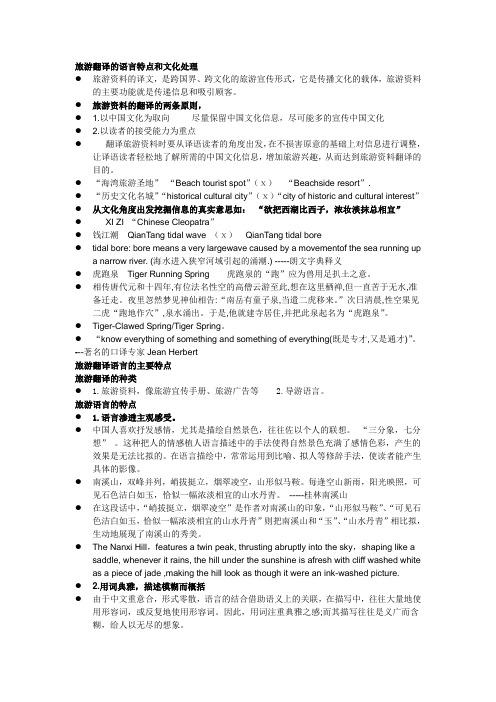
旅游翻译的语言特点和文化处理●旅游资料的译文,是跨国界、跨文化的旅游宣传形式,它是传播文化的载体,旅游资料的主要功能就是传递信息和吸引顾客。
●旅游资料的翻译的两条原则,● 1.以中国文化为取向尽量保留中国文化信息,尽可能多的宣传中国文化● 2.以读者的接受能力为重点●翻译旅游资料时要从译语读者的角度出发,在不损害原意的基础上对信息进行调整,让译语读者轻松地了解所需的中国文化信息,增加旅游兴趣,从而达到旅游资料翻译的目的。
●“海湾旅游圣地”“Beach tourist spot”(ⅹ)“Beachside resort”.●“历史文化名城”“historical cultural city”(ⅹ)“city of historic and cultural interest”●从文化角度出发挖掘信息的真实意思如:“欲把西湖比西子,浓妆淡抹总相宜”●XI ZI “Chinese Cleopatra”●钱江潮QianT ang tidal wave (ⅹ)QianTang tidal bore●tidal bore: bore means a very largewave caused by a movementof the sea running upa narrow river. (海水进入狭窄河域引起的涌潮.) -----朗文字典释义●虎跑泉Tiger Running Spring 虎跑泉的“跑”应为兽用足扒土之意。
●相传唐代元和十四年,有位法名性空的高僧云游至此,想在这里栖禅,但一直苦于无水,准备迁走。
夜里忽然梦见神仙相告:“南岳有童子泉,当遣二虎移来。
”次日清晨,性空果见二虎“跑地作穴”,泉水涌出。
于是,他就建寺居住,并把此泉起名为“虎跑泉”。
●Tiger-Clawed Spring/Tiger Spring。
●“know everything of something and something of everything(既是专才,又是通才)”。
「旅游英语」大自然的奇迹钱塘潮

「旅游英语」大自然的奇迹钱塘潮「旅游英语」大自然的奇迹钱塘潮钱塘潮是三大涌潮之一,是天体引力和地球自转的离心作用,加上杭州湾喇叭口的特殊地形所造成的特大涌潮。
在世界上,钱塘潮是世界三大涌潮之一。
下面,我们一起来看这篇英文文章,看看钱塘潮到底是多么地激荡人心。
Qiantang River is the biggest in Zhejiang Province, running from the west to Hangzhou Bay in the east. It serves as a river hinge, playing an important role in the water-transportation between the east and the west. It is encircled by a group of economically booming cities including Shanghai, China's leading industrial and commercial hub, and Ningbo, one of China's leading port cities. The extraordinary surging tide of the Qiantang River is a world-renowned natural wonder caused by the gravitational pull of the stars and planets. The centrifugal force produced by the rotation of the earth and by the peculiar bottleneck shape of Hangzhou Bay makes it easy for the tide to come in, but difficult for it to ebb.The soaring tide of the Qiantang River is such a marvelous spectacle that only the Amazon River's surging tide rivals it! Annually, millions of people from both home and abroad flock there to watch the magnificent tide on the eighteenth day of the eighth lunar month (also around the Mid-Autumn Day). When the surging tide comes, the water can rise up to a height of 30 feet and the noise it generates sounds like thunder, or thousands of horses running. Various activities will also be held to celebrate the annual Tide - Watching Festival, according to local custom. In terms of its history, the custom of watching the bore tide has happened for more than 2000 years. It first appeared during thefirst century. Then, it became popular in the Tang Dynasty (about 7th -13th century). Yangong town in Haijing 45 km (about 28 miles) from Hangzhou is the best place to watch the Qiantang Tide.The rushing tide can be dangerous if you are careless.So it's best to listen to the advice of the local policemen there whose job it is to ensure your safety and security.Crossing the river is the Qiantang River Bridge. It is China's first self-designed and self-built bridge, which took from April 1934 to Sept 1937 to complete. Qiantang River Bridge is comprised of its main body and the bridge approach, stretching a distance of 1453 meters (4767 feet). It is also the first modern double - layer bridge in China. The upper layer of the bridge is highway and the layer below is railway. Qiantang River Bridge is designed by the famous Chinese bridge engineer Mao Yisheng, who defied the words spoken by foreigners that it was impossible to construct a bridge in such a spot, and who made a great contribution to the Chinese bridge building industry. Looking out from the Six Harmonies Pagoda, one can get a panoramic view of the mighty Qiantang River, the majestic Qiantang River Bridge, and the surrounding landscape.【「旅游英语」大自然的奇迹钱塘潮】。
旅游导览口译

(8) 餐饮类
炸响铃 Fried bean-curd skin with meat
Jingle Bell (9) 建筑类
苏堤(现为晚上情人幽会之地) lovers& lane (10) 中国文化特指词
秦桧、王氏(秦妻)、万俟 、 张俊(岳飞墓前四跪像) the Ancient Gang of Four(即 古代四人帮 ,此译效果甚佳)
(5) 地理类 鱼米之乡-- Land of milk and honey ( 出自圣经,当然也能直译)
(6) 城市类 绍兴/苏州-- Oriental Venice
(7) 植物类 (其造型像)
球桧盆景 学名:Sabina chinensis (Linn.) Ant. cv. Globosa
A fro style (这种发型的旅游者听后很高兴)
所以,除事先告知汉语中“sunny day”暗指“love”,而“no sunny day (rainy day)”则 暗示 “no love”外,在读完英译文后,须再加一句“点睛之笔”———“No sunny day? But there is still love”,往往会获得“老外”的赞许声或掌声。
▶民间人物: 月下老人-- Chinese Cupid (The Old Man of the Moon)。
(2) 节气类 霜降-- Jack Frost (拟人化,使用时应注意上下文)
(3) 节日类 清明节– Chinese Easter (有十几种译名,此译名为旅游者所喜闻乐见) 三月三?
(4) 季节类 六月中之西湖-- West Lake in midsummer(不应译成 midJune )
The Beauty Xi Zi looks like the fair lady at her best. Whether she is richly adorned or plainly dressed.
关于潮州景区的作文英语
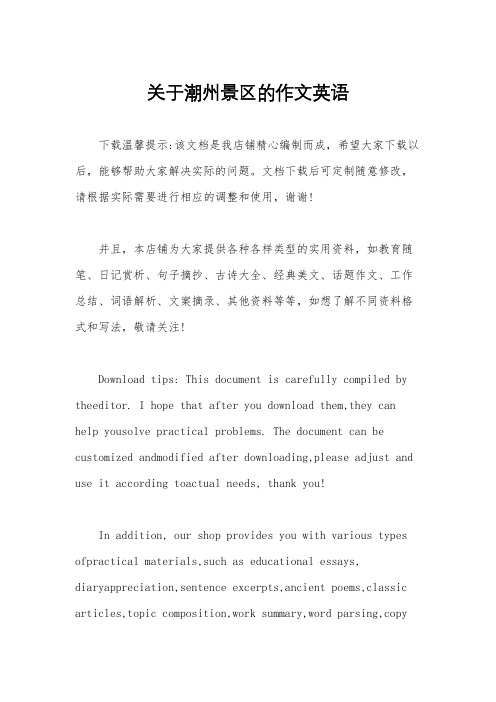
关于潮州景区的作文英语下载温馨提示:该文档是我店铺精心编制而成,希望大家下载以后,能够帮助大家解决实际的问题。
文档下载后可定制随意修改,请根据实际需要进行相应的调整和使用,谢谢!并且,本店铺为大家提供各种各样类型的实用资料,如教育随笔、日记赏析、句子摘抄、古诗大全、经典美文、话题作文、工作总结、词语解析、文案摘录、其他资料等等,如想了解不同资料格式和写法,敬请关注!Download tips: This document is carefully compiled by theeditor. I hope that after you download them,they can help yousolve practical problems. The document can be customized andmodified after downloading,please adjust and use it according toactual needs, thank you!In addition, our shop provides you with various types ofpractical materials,such as educational essays, diaryappreciation,sentence excerpts,ancient poems,classic articles,topic composition,work summary,word parsing,copyexcerpts,other materials and so on,want to know different data formats andwriting methods,please pay attention!Chaozhou is a beautiful city located in the easternpart of Guangdong Province, China. It is known for its rich history, unique culture, and stunning natural scenery. 。
实用旅游英语翻译(第八章)

第八章旅游文本中典故、诗词、俗语、楹联等的翻译第一模块:热身练习翻译下列文本,看旅游文本中一些文化现象在翻译中该如何处理:1.whicheven part of Scotland takes you fancy,history is never far away.You feel it in the brooding presence of Glencoe,evocative of that treacherous night in 1692 when Campbell soldiers slaughtered MacDonads as they slept. You touch it when you hike tyrough the hills and stumble across the ruins of a deserted shieling. You see it in the weatherworm stones of turreted castales. You hear in in rousing Border ballads and haunting Hebridean melodies.1.苏格兰令人心仪的地方都连着一段历史。
置身格伦科山谷,会感到历史之森然。
1692年那个背信弃义的冬夜,坎贝尔上尉率兵趁麦克唐纳族人熟睡时将他们杀害。
穿越绵绵山丘,偶见荒屋废墟时,能触摸到历史的脉搏。
在古堡塔楼那些风雨侵蚀的石块上,会看见历史的印记。
在动人的边区歌谣和难忘的赫布里底音乐中,会听见历史的回音。
2.Englishman Lesline Stephen wass one of the true pioneers of mountaineering. In 1871, when tourism in Switzerland was still in its infancy,he publishesd a book on climbing in the SwissAlps, aptly titled The Playground of Europe”.If Switzerland was a playground then-it certainly is now!But the country has changed,no longer offering stunning scenery,top-clsshotels,winter sports and convalescence to an exclusive few.Switzerland’s Jungfrau Region offers everything from perfect perfect peace to spectacular sport-at prices which compare favourably with other top tourist destinations.2.英国人莱斯利.斯蒂芬是真正的登山先驱之一。
汉英文化差异与西湖景点介绍的翻译——从奈达的功能对等理论角度
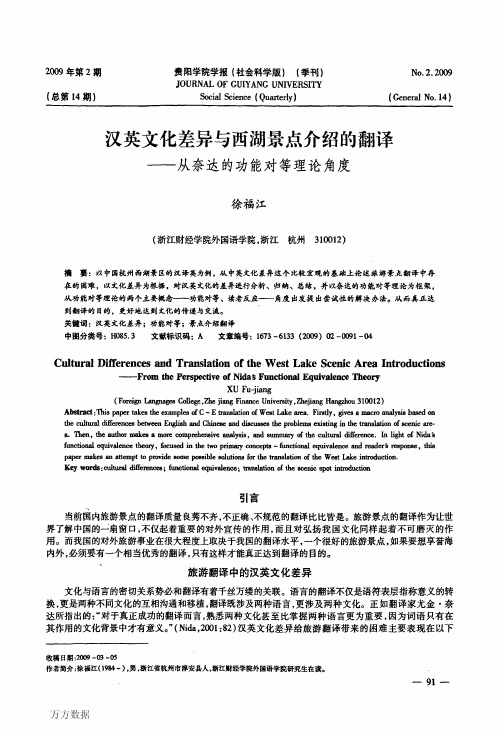
景点介绍的翻译主要侧重对文化内涵的理解,还必须结合语言的表达,应在最大程度上确保译文与原 文的最大近似值。景点介绍的翻译是为了让国外游客了解中国文化,增强旅游点的吸引力。为此,景点介 绍的翻译需要遵循“以中国文化为取向,以译文读者接受为重点”的基本原则,根据奈达的功能对等翻译 理论,判断译文质量的最终标准基于以下三个方面:(1)能使读者(接受者)正确理解原文信息,即“忠实原 文”;(2)易于理解;(3)形式恰当,吸引读者(接受者)。奈达提出“用最近似的自然对等值”,即“动态对 等”以及后来的“功能对等”概念,是因为他认为翻译要为接受者服务(receptor orientation),并使译文接受 者最大限度地准确无误地理解原文信息。具体翻译时可以采取以下方法:
a.Then。the author lllakeB&lnore comprehensive analysis,and sunmAary of the cultural difference.In tight of Nida's functional equivalence theory,focused in the two primary concepts—functional equivalence and reader台response,this paper makes an attempt to provide some possible solutiO[18 for the translation of the West Lake introduction. Key words:cultural differences;functional equivalence;translation of the scenic spot introduction
- 1、下载文档前请自行甄别文档内容的完整性,平台不提供额外的编辑、内容补充、找答案等附加服务。
- 2、"仅部分预览"的文档,不可在线预览部分如存在完整性等问题,可反馈申请退款(可完整预览的文档不适用该条件!)。
- 3、如文档侵犯您的权益,请联系客服反馈,我们会尽快为您处理(人工客服工作时间:9:00-18:30)。
从《钱江涌潮》英译文谈旅游英语翻译技法
《钱江涌潮》
The Tidal Bore of the Qiantang River
八月十八潮,On the eighteenth of the eighth lunar month,
壮观天下无The tidal bore of the Qiantang River, Is a grand view second to none on earth.
浙江钱塘江河口的涌潮,自古蔚为天下奇观。
它是大自然赋予的神奇景象。
由于天体引力和地球离心作用,每逢农历初一至初五,十五至三十,天体引潮力特别强,易形成大潮;农历八月十八日的大潮尤为壮观。
而杭州湾喇叭口的地形特殊,海湾水域广阔,但河口狭窄,加之河床泥沙阻挡,易使潮流能量集中,江潮迅速猛涨,流速加快,涌潮现象频频发生。
钱江涌潮,一年四季,周而复始。
全年共有120天的“观潮日”。
The tidal bore located at the mouth of the Qiantang River in Zhejiang affords a magnificent view and constitutes a remarkable natural phenomenon. The bore is at its highest from the first day to the fifth, and from the fifth day to the twentieth every month according to the lunar calendar. At this time, the moon and the sun exert the greatest pull on the ocean at the mouth of the Qiantang River. The bore is at its most spectacular every September on the eighteenth day of the lunar calendar’s eighth month. The river’s special physical features account for this remarkable natural phenomenon. Its outlet to the ocean, Hangzhou Bay, is extremely wide, shaped like a large trumpet. When the sea tide rises, it brings with it a huge amount of water, pushing inland at a great speed. However, the river narrows abruptly at this point. This, together with the river’s sandy bed, prevents the water’s smooth progress. As waves follow one after the other, the tide surges and creates a gigantic wall of tidal water, the so-called “tidal bore”. The tidal bore operates in a cycle; there are only 120 days on which it is good to watch the bore. Moreover, there are two tides per day, the day tide and the night tide.
每天有日、夜两潮,尤以秋潮为最佳。
每当大潮来时,开始远处呈现一条白线,声如闷雷。
数分钟之后,白线向前推移;继而巨浪汹涌澎湃,如万马奔腾,潮声震天动地,真有翻江倒海之势,最高潮差8.93米。
钱塘江涌潮举世无双,其奇、其高可与亚马逊河媲美,被誉为“世界八大奇观”之一。
The tides are greatest in autumn, the most spectacular time to view it. On the September day when the greatest tidal bore first appears, it is shaped like a long, white streak, and one hears a sound like muffled thunder in the distance. A few minutes later, a long, white streak of water chases itself down the river. As the tidal waves travel upstream, the water piles up higher and higher, as though tens of thousands of untamed horses were galloping upstream. The deafening noise inspires awe and admiration. Tidal waves created by the bore are known to have reached 8.93 meters in height. The tidal bore of the Qiantang River is now considered to be one of “the Eight Wonders in the World.” Its unique shape and height have been compare d to those of the Amazon River.
素练横江滚滚来——“一线潮”“A long, white streak rolls in horizontally lie a silk scroll.”
明末以来,随着江河变化,钱塘江涌潮向下推移,海宁的盐官镇成了观潮的最佳胜地。
涌潮每到占鳌塔时,便成一字形,故名“一线潮”。
Because of changes in the watercourse since the end of the Ming Dynasty, the tidal bore has gradually retreated lower down the Qiantang River. Nowadays the town of Yanguan in Haining City affords an excellent spot from which to view the bore. When the tidal waves reach the Haining Pagoda, they appear as a long, white streak. Thus it is called the “Thread Bore”.
漫漫平沙起白虹——“W形潮”“A wall of waves stands abrupt against the horizon.”
涌潮到达眼前时,有万马奔腾之势、雷霆万钧之力,势不可挡,时而形成“V字潮”,时而成“S形潮”,时而形成“W形潮”。
The tidal waves seem to pile on top of another, in a force similar to that created by thousands of wild horses. Here, one hears a muffled roar, as the tidal bore approaches nearer and nearer. It first appears in the shape of a “V”, then as an “S”, and finally, as a “W”; thus it is called “W-shaped Bore”.
卷起沙堆如雪堆——“返头潮”“Wonderful waves roll by, creating enormous clouds of foam.”
潮水猛冲,凸入江中的围堤,形成“卷起沙堆如雪堆”的“返头潮”。
As the waves crash against the river’s bank, they create enormous clouds of silvery foam. Hence the name “Backflow Bore”.
钱江后浪推前浪——“重叠潮”In the Qiantang River the waves behind drive on those ahead.”
涌潮经过长途奔袭,中途受到各种障碍物的阻挡,到达距钱塘江口50多公里的六和塔时,已支离破碎,形成多头、多层、多叠的潮水,给人以“后浪推前浪”之感。
Having traveled a long distance, the tidal bore gradually decreases in power. The tidal bore finally reaches the Six Harmonies Pagoda in Hangzhou, located about 50 km. away from the mouth of the Qiantang River. Here one can see the waves behind driving on those ahead, overlapping each other, so it is called the “Overlapping Bore”. 郭建中[译] 浙江大学英语博士生导师。
